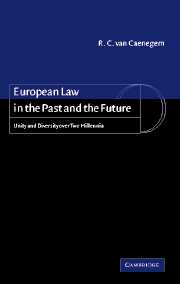Book contents
- Frontmatter
- Contents
- Preface
- 1 The national codes: A transient phase
- 2 Ius commune: The first unification of European law
- 3 Common law and civil law: Neighbours yet strangers
- 4 The holy books of the law
- 5 Why did the ius commune conquer Europe?
- 6 Law is politics
- Epilogue: A look into the twenty-first century
- Bibliography
- Index
3 - Common law and civil law: Neighbours yet strangers
Published online by Cambridge University Press: 06 August 2009
- Frontmatter
- Contents
- Preface
- 1 The national codes: A transient phase
- 2 Ius commune: The first unification of European law
- 3 Common law and civil law: Neighbours yet strangers
- 4 The holy books of the law
- 5 Why did the ius commune conquer Europe?
- 6 Law is politics
- Epilogue: A look into the twenty-first century
- Bibliography
- Index
Summary
SIX CONTRASTING AREAS
It may be useful for a better understanding of the unification debate to proceed to a more precise and technical analysis of the differences between the common law and what the famous comparatist René David used to call the famille romano-germanique. We shall therefore distinguish six particular areas where the differences are both striking and fundamental, following the analysis by Peter Stein, Regius Professor Emeritus of Civil Law in the University of Cambridge and a jurist who is well acquainted with the laws of his own country and those – ancient and modern – of the Continent.
But first a word of warning about the Roman law of Antiquity and the Roman or civil law of medieval and modern Europe. It is a fact that European neo-Roman law is entirely based on the Roman law as recorded in Justinian's Corpus iuris, but it would be a mistake to think of the classical Roman law of the great jurists, who worked centuries before Justinian put his commission of jurists to work, as looking in any way like the treatises of Bartolus and Baldus or the Pandektenrecht of Bernhard Windscheid (d. 1892). On the contrary, the Roman law of the classical period is in many respects closer in character to the English common law than to the modern civil-law systems which are derived from the medieval schools.
- Type
- Chapter
- Information
- European Law in the Past and the FutureUnity and Diversity over Two Millennia, pp. 38 - 53Publisher: Cambridge University PressPrint publication year: 2001

